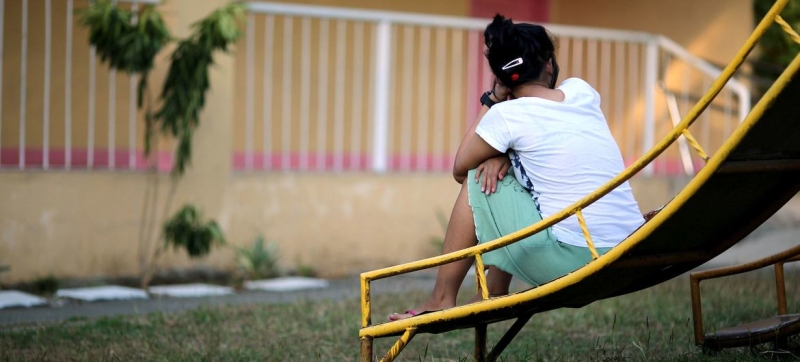
Girls are mostly trafficked for sexual exploitation, while boys are trafficked for forced labor. Pictured: A shelter for abused girls in the Philippines. EXPLAINED | No child left behind in the fight against human trafficking Peace and Security
World Day Against Trafficking in Persons is observed on July 30. This year, the theme is “No child left behind in the fight against human trafficking.”
The United Nations Office on Drugs and Crime (UNODC) has produced a fact sheet on child exploitation to raise awareness of this global problem and call for greater action to stop human trafficking.
What is child trafficking?
Child trafficking involves the use of a child by criminals for the purpose of exploitation. It is a serious crime and a violation of human rights, even if the child appears to have somehow “consented” to the exploitation. Force, fraud, coercion, abuse of power, or vulnerability are often used.
Children can be exploited in many different ways. Among them are:
-
Sexual exploitation, which may include the abuse of children for the purposes of commercial sexual exploitation or the production of child sexual abuse material;
-
Forced labor: children work in harsh conditions in a variety of sectors, including agriculture, factories, mining, or as domestic servitude;
-
Beggaring and petty crime: children are forced to beg on the streets or to commit crimes such as theft;
-
Children in armed conflicts are recruited as combatants, subjected to sexual exploitation or kept in domestic servitude;
-
Child marriage: girls are married off for money or to gain social status, often as part of harmful traditional practices;
-
Illegal adoption: babies and children are trafficked for illegal adoption for the purpose of exploitation, often through deception or coercion of their parents or guardians.
Sometimes victims of child trafficking are subject to more than one form of exploitation. For example, a child who is forced to beg on the street may also be subject to sexual exploitation.
How common is child trafficking?
In 2020 UNODC documented nearly 20,000 cases of child trafficking. However, due to difficulties in identifying exploitation and official reporting, the actual number may be much higher.
Over the past 15 years, the proportion of children among identified victims of human trafficking has tripled. Approximately every third identified victim is a child.
Both girls and boys are victims of human trafficking, but it can affect children differently depending on their gender and location. Girls are primarily trafficked for sexual exploitation, while boys are trafficked for forced labor.
Where does child trafficking occur?
Child trafficking occurs worldwide, but with regional specificities. For example, in North Africa and sub-Saharan Africa, children make up the majority of victims of human trafficking, with forced labor being most prevalent in sub-Saharan Africa.
However, in Central America and the Caribbean, the majority of identified victims are girls, mostly teenagers, victims of sex trafficking. In South Asia, nearly half of the victims are children, exploited as laborers or forced into marriage.
How children become vulnerable before exploitation?
Child trafficking thrives in contexts of family dysfunction, poverty, inequality, inadequate protection and lack of parental care. Criminals often target children from extremely poor families or those who have been abandoned by their parents or guardians. Conflict, economic problems and environmental disasters make children, especially unaccompanied and separated migrant youth, more vulnerable.
While many traffickers are hardened criminals, they can also be local business owners, intimate partners, and family members.
Traffickers use online platforms, social media, and the dark web to contact, exploit, and control children. They use modern technology to evade detection and distribute violent content.
Children’s unsupervised use of the internet and social media, often without proper safety measures, can further expose them to exploitation.
How Child Trafficking Impacts Victims and Society?
The crime has devastating consequences for the physical, cognitive, and socio-emotional development of children. Victims often suffer lifelong health problems, trauma disorders, anxiety, depression, and difficulties in social integration. Children are almost twice as likely to be subjected to extreme violence by traffickers compared to adult victims, with the rate even higher for girls.
Read also:
Kazakhstan Tightens Anti-Trafficking Laws
Child trafficking disrupts education, undermines social structures, and perpetuates poverty and exploitation. It destroys childhoods and can trap child victims in a cycle of violence as they grow into adults.
Such crimes hinder the development of communities. Combating child trafficking is critical to achieving broader social and economic stability and community cohesion.
What UNODC is doing to address the problem?
The United Nations Office on Drugs and Crime works to raise awareness of this global problem and mobilize action to stop child trafficking, and conducts research on the topic.
UNODC also provides technical support to States in preventing crimes, administering justice and protecting victims, as well as in the effective implementation of the Global Protocol to Prevent, Suppress and Punish Trafficking in Persons, Especially Women and Children. The UN Office develops guidelines on justice and protection measures to help children who are victims of exploitation. It also analyses precedents to identify gaps in investigations, prosecutions and sentencing and makes recommendations to countries accordingly.
UNODC coordinates the Inter-Agency Coordination Group against Trafficking in Persons. In 2023, this UN forum, co-chaired by the International Organization for Migration (IOM) and the Office of the Special Representative of the Secretary-General on Violence against Children, called for accelerated action to prevent and end child trafficking by 2025.
